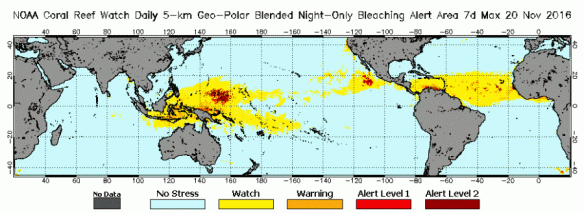GR: Natural disasters are growing, but media attention focuses on politics and material matters, giving emphasis to wealth and society and overlooking environmental problems. Thus, America’s shock troops, its police and military mercenaries, are emboldened to make unrestrained attacks on citizens striving to limit fossil fuel development. This story by Robert Scribbler explains why the disastrous addition of CO2 and heat to the oceans is destroying and will continue to destroy some of the most beautiful and productive places in the sea.
“From October of 2014 through June of 2016, the world was in the grips of a powerful El Nino. And throughout this event, the oceans spewed back some of the massive volume of heat they’ve been accumulating in their depths due to global warming. As a result, atmospheric and ocean surface temperatures hit new record highs. And during 2016, global surface temperatures will likely average 1.2 C hotter than 1880s levels. This amount of warming is as considerable as it is harmful.
Current-coral-bleaching-status

The Worst Global Coral Bleaching Event Ever Recorded…
“This new record spike in global surface temperatures set off the worst coral bleaching event ever recorded. Around the world, reef systems came under severe stress as sea surface and near surface temperatures exceeded 28-30 degrees Celsius.
“Among the hardest hit regions were the reefs of Kiribati. There, sea surface temperatures hit up to 31.4 C on an extended basis. Such hot waters are now expected to have wiped out all but 1 to 5 percent of Kiribati’s living corals. So, for all practical purposes, the reefs of that island republic have been wiped out.” –Robert Scribbler (continue reading: Why the Global Coral Bleaching Event That Began in 2014 May Just Keep Going and Going)

